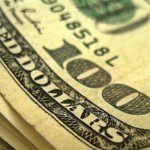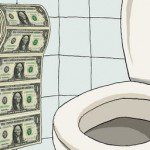Stocks are up. Bonds are expensive. Dollar cash is unlikely to preserve purchasing power in an environment of negative real rates. Diversifying to a basket of hard currencies might help to mitigate some of the risks out there. It clearly adds currency risk but in an environment where there may not be such a thing as a risk free asset, it might be a risk worth pursuing…
power in an environment of negative real rates. Diversifying to a basket of hard currencies might help to mitigate some of the risks out there. It clearly adds currency risk but in an environment where there may not be such a thing as a risk free asset, it might be a risk worth pursuing…
So writes Axel Merk (www.merkinvestments.com) in edited excerpts from his original article* entitled Sell the Dollar? Case for Hard Currencies.
[The following article is presented by Lorimer Wilson, editor of www.munKNEE.com and may have been edited ([ ]), abridged (…) and/or reformatted (some sub-titles and bold/italics emphases) for the sake of clarity and brevity to ensure a fast and easy read. This paragraph must be included in any article re-posting to avoid copyright infringement.]
Merk goes on to say in further edited excerpts:
[With] the dollar up and bonds down as a result of the Fed’s “tapering” is this the time to bet on the greenback, or to diversify out of the dollar? We believe the dollar may not only have gotten ahead of itself, it also rallied for the wrong reasons. Only the future will tell whether this is an opportunity to sell the dollar, but we can look at risks and opportunities presented.
Fed Exit?
Perhaps: It appears to us that the Federal Reserve is on a coordinated effort to prepare the market for an “exit” of quantitative easing... We can see three reasons why the Fed may want to do this:
- The Fed is in earnest considering unwinding its asset purchase programs;
- The Fed is concerned about asset bubbles building; and/or
- The Fed is testing the market reaction as it realizes an exit will be a major challenge and has to start somewhere preparing the markets.
Perhaps Not: Looking at fundamentals in the economy, however, we see lots of arguments why Bernanke might want to print more, not less money:
-
Manufacturing activity contracted to a four-year low in May…to 49.0 from 50.7 in April, short of expectations.
-
While recent unemployment reports showed positive headlines, U6, an unemployment measure also counting those “marginally attached to the workforce for economic reasons,” inched up in May. Instead of being on a hiring spree, employers seem to be pushing full-time employees into part-time positions as employers get ready for mandatory health insurance for full-time employees under Obamacare. More people have jobs, but they don’t earn enough to make a living. That’s not the recovery the Fed wants to see.
-
Home prices are up but copper and lumber prices are in deep bear market territory, suggesting that the “housing recovery” is a financially engineered one, unlikely to lead to a boom in the construction sector.
-
Inflation expectations are down. While the Fed has a difficult time gauging just about anything in the markets these days, as it manages the entire yield curve (short-term through long-term interest rates), the gauges generally point to a cooling of inflation expectations. More so, while they are within the Fed’s general comfort zone, they are below what we believe Bernanke has in recent years been eager to see.
Asset Bubbles? For Sure!
If it’s not the economy the Fed is so excited about, maybe the Fed is concerned about asset bubbles. Ever since former Fed Chair Greenspan’s “irrational exuberance” speech in the 1990s, the Fed has been most careful about talking down asset prices yet Bernanke has been rather eager to point to a higher S&P500 index as proof that QE is working. The trouble with such talk is that it raises expectations the Fed will come to the rescue when asset prices plunge.
However,
- with equity prices through the roof;
- with news stories on a resurgence of “house flipping”;
- with “cov-light loans” all the rage (loans providing little guarantees/collateral) again,
a rational observer shall be excused for concern about valuations.
Exit Talk Trial Balloon
The Fed printed all this money because it believes (we disagree) money printing will bring the economy back to life so why not… send up a trial balloon to see how the markets might react if and when the tapering starts except that we don’t think what we are witnessing is a trial run of an unwinding at the Fed. A true unwinding would be a rather different ride. More on that below.
_____
Save time! Here are 4 ways to access the best articles on the internet!
Sign up for our FREE Market Intelligence Report newsletter (sample)
“Follow the munKNEE” daily posts via Twitter or Facebook
Set up an RSS feed: It’s really easy – here’s how
_____
Sympathetic Dollar
The above said, the dollar has experienced a formidable rally on the backdrop of the “tapering” talk. [See here for the most recent chart on the U.S. Dollar Index] Some of that relates also to the headwinds in other parts of the world:
- With commodity prices under pressure, commodity currencies have had a rough time.
- With the Eurozone under ongoing economic pressure, the euro continues to be unloved.
- With Japanese policy makers doing their share to egg on hedge funds to accelerate the currency’s demise the yen has fallen out of bed.
Investors have a difficult time envisioning how they can be bearish on the dollar when they are not positive on anything else either. We sympathize with that view with regard to at least some commodity currencies and the yen, but see value in others, most notably the euro.
The Unloved Euro
There has been buzz about negative deposit rates at the European Central Bank (ECB) and generally a doom and gloom atmosphere portrayed in much of the media. We think the more prudent heads at the ECB will prevail:
- German manufacturing numbers inch closer to expansion,
- the cost of borrowing for peripheral Eurozone countries has come down steadily providing a major stimulus and, finally,
- at the most recent downgrade of Cyprus (yes, there was another one just last Monday), the euro didn’t blink, but held its gains for the day.
A lot of good news is priced into the dollar. A lot of bad news is priced into the euro. Given the choice, we’d rather hold the euro…
The Other Dollars
With regard to commodity currencies, we tend to agree that the odds are not stacked in their favor; having said that, each commodity currency has its own set of dynamics.
Australia: The best thing going for the Australian dollar may well be that it has declined so much. If history is any guide, the Australian dollar should be rather weak as economic growth slows “Down Under.” Japan’s refurbished printing press is actually keeping the Australian dollar from falling more.
New Zealand: The New Zealand dollar next door is far better off, with its economy more exposed to soft commodities. The governor of the Reserve Bank of New Zealand has expressed an interest to join the “currency wars,” talking down the kiwi. With little success, though as the New Zealand dollar, while relatively strong for the right reasons, is not cheap.
Canada: The one bright spot we see in that space is the Canadian dollar. The Bank of Canada is now freed of Mark Carney, who may now be trash-talking the British pound sterling. We believe that, on a relative basis, the Canadian dollar is cheap.
Other Currencies
The South African rand and Brazilian real have domestic issues that make us stay away from these currencies.
The Japanese yen is a bit of a different story, possibly taking a breather from the rather radical policies to jump-start the ailing Japanese economy. Just because the Japanese yen has been strengthening for a few days doesn’t mean Japan is out of the woods. Indeed, the canary in Japan’s coalmine are Japanese Government Bonds (JGBs). We don’t see how Japan can finance itself in the medium term, especially not if Abenomics is successful. The Bank of Japan may cap the borrowing cost at some point by buying unlimited amounts of JGBs. The yen may not survive Abenomics. Japan may be proof that we never had a Eurozone crisis, but that we have a global crisis.
Sell the Dollar?
Let’s consider a couple of other points:
- Unlike what pundits wants to make us believe, economic growth may not be good for the U.S. dollar. That’s because the bond market may turn into bear market territory and, given that foreigners buy a lot of Treasuries, this may not bode well for the U.S. dollar. Historically, it’s only in the late phases of a tightening cycle that the dollar…benefits as the next bull market in Treasuries is anticipated. We don’t think the current cycle has much precedent in history, but it is something to keep in mind. Aside from a general uptick in volatility, challenges in the bond market may put the spotlight onto an unsustainable U.S. government deficit. Without entitlement reform, the tailwinds produced by more domestic energy production won’t make up for the challenges ahead and it’s not about the numbers; it’s about the perception of the sustainability. Instead of trying to time a change in sentiment, investors may want to take precautions when they acknowledge the risks.
- We don’t have the “cleanest dirty shirt”; the U.S. shirt is dirty, but we feel good wearing it. Last year, by the way, the dollar went down about 1.7% versus the euro; as of this writing, the greenback is up 0.8% year-to-date versus the euro.
Conclusion
Stocks are up. Bonds are expensive. Dollar cash is unlikely to preserve purchasing power in an environment of negative real rates. Diversifying to a basket of hard currencies might help to mitigate some of the risks out there. It clearly adds currency risk but in an environment where there may not be such a thing as a risk free asset, it might be a risk worth pursuing…
[Editor’s Note: The author’s views and conclusions in the above article are unaltered and no personal comments have been included to maintain the integrity of the original post. Furthermore, the views, conclusions and any recommendations offered in this article are not to be construed as an endorsement of such by the editor.]
*http://www.merkinvestments.com/downloads/2013-06-13-sell-the-dollar.pdf (© 2013 Merk Investments LLC® | www.merkinvestments.com)
Related Articles:
1. The USD is HOT! What Gives?
The US Dollar is HOT so what gives? It rallied in 2012 and has gone nuclear in 2013. According to Morgan Stanley it’s because of…. Read More »
2. The Myth of the Rising U. S. Dollar
Year-to-date, the dollar index, a trade weighted index comparing the U.S. dollar to a basket of six major currencies (Euro @ 57.6% weight, Japanese yen 13.6%, Pound sterling 11.9%, Canadian dollar 9.1%, Swedish krona 4.2% and Swiss franc 3.6%) is up 2.95% as of April 29, 2013 – but the U.S. Dollar Index is not the U.S. Dollar. To ascertain what may happen to the U.S. dollar, let’s look at the greenback from a couple of different angles Read More »
3. What’s Happened – and Will Continue to Happen – to the Value of the U.S. Dollar
Technically the U.S. left the gold standard in 1971 but, in reality, we abandoned it in 1913 with the creation of the Fed…setting the stage for the collapse of the dollar. [Given that this is] the 100th anniversary of the creation of the Federal Reserve, it seems only fitting that we should present a brief history of the U.S. dollar debasement since then. Words: 1144 Read More »
4. What Is “The Carry Trade” & Why Is It So Misunderstood?
These days any time anyone shorts the yen—or any currency with below average interest rates for that matter—it gets referred to by some strategist or equity investor as ‘the carry trade’ – but it is wrong. Below is a clear description of what a carry trade is – and isn’t – and why it is so prevasively misunderstood. Words: 714 Read More »
5. Which Country Will Win the Race to Debase Its Currency the Most?
 munKNEE.com Your Key to Making Money
munKNEE.com Your Key to Making Money


